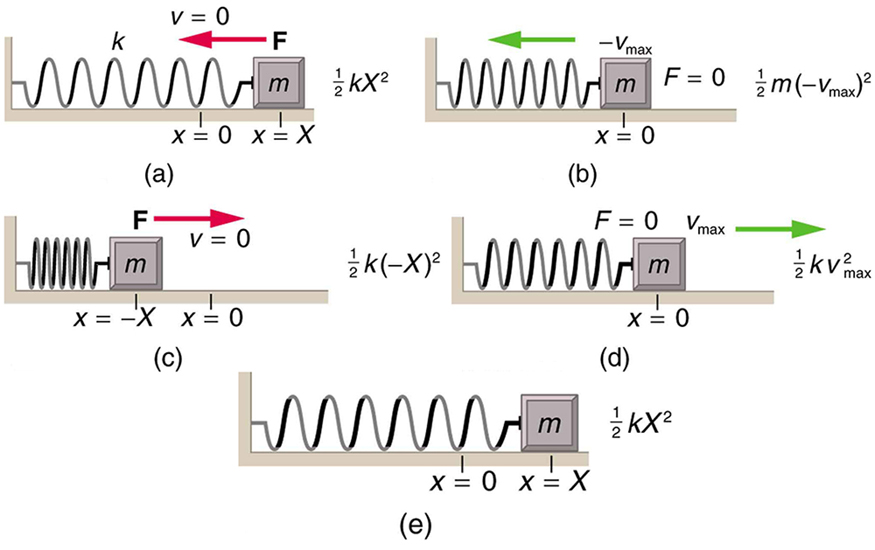| << Chapter < Page | Chapter >> Page > |
Damping oscillatory motion is important in many systems, and the ability to control the damping is even more so. This is generally attained using non-conservative forces such as the friction between surfaces, and viscosity for objects moving through fluids. The following example considers friction. Suppose a 0.200-kg object is connected to a spring as shown in [link] , but there is simple friction between the object and the surface, and the coefficient of friction is equal to 0.0800. (a) What is the frictional force between the surfaces? (b) What total distance does the object travel if it is released 0.100 m from equilibrium, starting at ? The force constant of the spring is .

Strategy
This problem requires you to integrate your knowledge of various concepts regarding waves, oscillations, and damping. To solve an integrated concept problem, you must first identify the physical principles involved. Part (a) is about the frictional force. This is a topic involving the application of Newton’s Laws. Part (b) requires an understanding of work and conservation of energy, as well as some understanding of horizontal oscillatory systems.
Now that we have identified the principles we must apply in order to solve the problems, we need to identify the knowns and unknowns for each part of the question, as well as the quantity that is constant in Part (a) and Part (b) of the question.
Solution a
Discussion a
The force here is small because the system and the coefficients are small.
Solution b
Identify the known:
Discussion b
This is the total distance traveled back and forth across , which is the undamped equilibrium position. The number of oscillations about the equilibrium position will be more than because the amplitude of the oscillations is decreasing with time. At the end of the motion, this system will not return to for this type of damping force, because static friction will exceed the restoring force. This system is underdamped. In contrast, an overdamped system with a simple constant damping force would not cross the equilibrium position a single time. For example, if this system had a damping force 20 times greater, it would only move 0.0484 m toward the equilibrium position from its original 0.100-m position.
This worked example illustrates how to apply problem-solving strategies to situations that integrate the different concepts you have learned. The first step is to identify the physical principles involved in the problem. The second step is to solve for the unknowns using familiar problem-solving strategies. These are found throughout the text, and many worked examples show how to use them for single topics. In this integrated concepts example, you can see how to apply them across several topics. You will find these techniques useful in applications of physics outside a physics course, such as in your profession, in other science disciplines, and in everyday life.
Why are completely undamped harmonic oscillators so rare?
Friction often comes into play whenever an object is moving. Friction causes damping in a harmonic oscillator.
Describe the difference between overdamping, underdamping, and critical damping.
An overdamped system moves slowly toward equilibrium. An underdamped system moves quickly to equilibrium, but will oscillate about the equilibrium point as it does so. A critically damped system moves as quickly as possible toward equilibrium without oscillating about the equilibrium.
Give an example of a damped harmonic oscillator. (They are more common than undamped or simple harmonic oscillators.)
How would a car bounce after a bump under each of these conditions?
Most harmonic oscillators are damped and, if undriven, eventually come to a stop. How is this observation related to the second law of thermodynamics?
The amplitude of a lightly damped oscillator decreases by during each cycle. What percentage of the mechanical energy of the oscillator is lost in each cycle?

Notification Switch
Would you like to follow the 'College physics' conversation and receive update notifications?